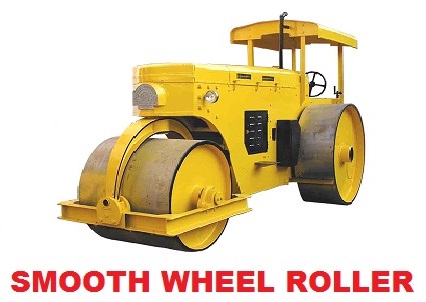
Following are the equipments used for the compaction of earth:
1. Smooth Wheel Roller
2. Sheep Foot Roller
3. Pneumatic Roller
4. Tamping Roller
5. Grid Roller
6. Vibratory Roller
1. SMOOTH WHEEL ROLLER:
- This types of roller incorporates a large steel drum at the front and one or two wheels or drums at the rear.
- If their is one wheel at the rear they are known as Tandem roller, and Three wheeled roller if there are two wheels at the rear.
- The weight of tandem roller varies from 2-8 tonnes and three wheeled roller varies from 8-10 tonnes.
- The ground pressure exerted by tandem roller is typically around 10-17 kg/cm2.
- The weight of roller increased by blasting with sand, water or pig iron.
- Smooth wheel roller are most suitable for consolidating stone, gravel, sand, hardcore and ballast but are not suitable for embankments, soft sub-grades or uniform sand.
- The Speed and number of passes of a smooth wheel roller depends on the types of soil to be compacted and project requirements.
- The optimum working speed has found to be 3-6 km/h and about 8 passes are adequate for compacting 20 cm layer.
- The smooth wheel roller leaves the surface smooth after compaction.

2. SHEEP FOOT ROLLER:
- Sheep foot roller consist of a steel drum on which round or rectangular protrusions known as lugs or feet are fixed.
- There are different types of lugs such as spindle shaped with widened base, prismatic and clubfoot.
- Sheep foot roller are used for compacting fine grained soil such as heavy clay and silty clay. They are used for compaction of soils in dam, embankments, sub-grade layers in pavements and rail road construction projects.
- Coverage area of sheep foot roller is less about 8-12 % because of the boots on drums.
- Contact pressure of this type roller varies from 1200-7000 Kpa.
- Area of each protrusions in sheep foot roller varies from 30-80 cm2.
- Generally 10-20 passes are required to provide complete coverage on the soil and top layer of consolidated soil finished by smooth wheel roller.
- Factors that governs the amount of compaction of soil are-

1- Weight of roller
2- Area of each lugs
3- No. of lugs in contact with the ground
4- No. of lugs per drum
3. PNEUMATIC ROLLER:
- Pneumatic roller consist of a heavily loaded wagon with with several rows of closely spaced tyres. They are also known as rubber tyred roller.
- They provide uniform contact pressure through out the width covered and are often used in pavement sub-grade works.
- They are suitable for compacting uniform coarse soil and rock. They are also used to finish embankment compacted by sheep foot roller.
- The factors which affect the amount of compaction that can be achieved are the weight, tyre inflation pressure and the area of contact.
- Coverage area of pneumatic roller is about 80%.
- Contact pressure of pneumatic roller ranges from 500-700 Kpa.
- The optimum speed of roller is between 6-24 km/h and maximum density can be achieved by 8 passes of the roller.
- The gross weight of roller 6-10 tonnes which can be increased to 25 tonnes by ballasting.

4. TAMPING ROLLER:
- The tamping rollers are similar to sheep foot roller.
- Tamping roller consist of four wheels and one each wheel kneading boots/feet are fixed.
- These roller also consist of leveling blades to spread the material.
- Tamping roller has more coverage area about 40-50%.
- Contact pressure of tamping roller varies from 1400-8500 Kpa.
- Tamping roller is best dedicated for fine grained soils.
- Tamping roller have static weight in the range of 15-40 tonnes and their static linear drum loads are between 30-80 kg/cm.
- The degree of compaction achieved is more than sheep foot roller and density achieved by tamping roller after compaction is more uniform.

5. VIBRATORY ROLLER:
- Vibratory roller have fitted with one or two smooth surfaced steel drums measuring 0.9-1.5 in diameter and 1.2-1.8 in width.
- The drum vibrates by the rotation of an electric shaft inside.
- Vibratory roller are commonly used for compacting granular base course and some times for asphalt.
- Tamping roller have higher output and improved performance compared to other rollers.

6. GRID ROLLER:
- Grid roller have a cylindrical heavy steel surface comprising a network of steel bars which form a grid with square shaped holes.
- They are typically used for the compaction of well graded coarse soil and weathered rocks, often in sub-grades and sub-base road projects.
- They are not suitable for clayey soil, silty clay or uniform soil.
- The weight of grid roller con be increased by ballasting with concrete blocks.
- Typical weight of grid roller vary between 5.5 tonnes net and 15 tonnes ballasted.
- This roller provides higher contact pressure but little kneading action.


